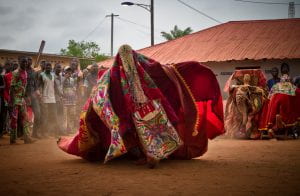
On Thursday, April 5, UAB hosted Dr. John Thabiti Willis, Associate Professor of African History at Carleton College, to discuss the relationship between masquerading traditions of the Yoruba people in Nigeria and hip hop. The Yoruba people are a West African ethnic group of 30 million worldwide; nearly 25 million live in Nigeria.
Dr. Willis’ 19-month long archival and ethnographic investigation was to understand how such traditions arrived in Otta, an ancient Yoruba town that represents some of those most elaborate masquerades. Dr. Willis discovered that a religious leader James White arrived at Lagos in 1852, becoming the first person to preach the gospel in the region. To appeal the local Yoruba people to Christianity, White recruited musicians to perform local melodies which become early influence for Christian music in the region. Today, masquerades in Otta are notable spectacles that celebrate social rites and acknowledge political causes.
Willis’ lecture primarily focused on the masquerade tradition of Egungun, an honoring of ancestors and their living descendants, which originated in Old Oyo. The Egungun masquerades are performed by men masked and veiled in lavish fabric, to conceal the carrier and reveal unseen forces/spirits, while women participate in the harmonics. Performance garments include Burial Shrouds (death), Resurrection (of the deceased) and New Clothes (new life).
Another masquerade tradition, Gelede, originating in Ketu, honors women as mothers. Masked performance symbolism includes: Women (productive and reproductive labor), Foreign Men (productive labor: economic, political and religious) and Mother Nature (nature as the primordial mother). As opposed to Western traditions that prioritize male dominance and the individual, the masquerades center on African indigenous sentiments which champion men and women as leaders, coalitions and support of the people.
Reflecting on these findings, Dr. Willis identified five main elements of masquerading that carry striking similarities with elements of hip hop performance:
| Masquerading | Hip Hop |
| Drumming (rhythm masking) | DJing |
| Verbal Arts (praise-singing and poetic performances | MCing |
| Masked Dancing (choreographed and improvised) | B-Boying/Break-Dancing |
| Visual Art (mural paintings) | Graffiti |
| Biological and Ritual Kinship (community, identity & purpose) | Knowledge |
Though Dr. Willis originally journeyed to Nigeria to understand the masquerading origins of Otta, he discovered this how masquerading and hip hop convey similar narratives with different cultural contexts. Much like masquerading, hip hop, too, can reveal the power of metaphor, as demonstrated in Soul Sonic Force’s 1983 classic “Renegades of Funk”, allowing viewers to reflect on social and political power dynamics as well as enable discourse expression through performance of power.
